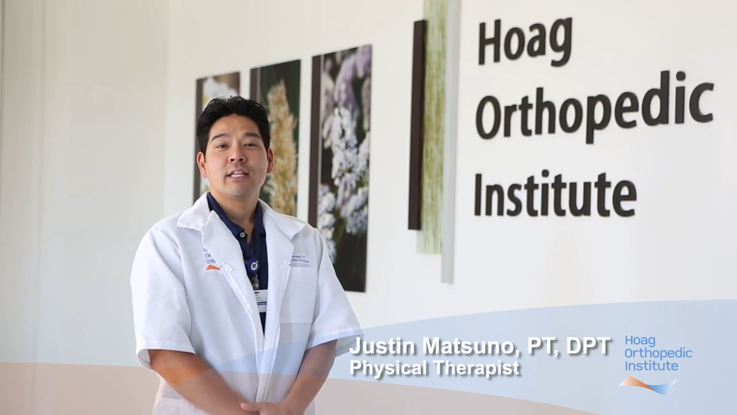Microdiscectomy–Surgical Treatment for a Herniated Disc
If you experience chronic pain from a lumbar herniated disc or sciatica, simple activities like walking, sitting, and standing can be a challenge. When conservative treatments, such as physical therapy and medication haven’t provided relief after at least three months, you may be a good candidate for a microdiscectomy.
Results are better for patients who do not wait much longer than three months after diagnosis to undergo microdiscectomy, so it’s important to discuss whether microdiscectomy surgery is right for you with a board-certified and fellowship trained spine surgeon at Hoag Orthopedic Institute.
What is Microdiscectomy?
Also known as microcompression, microdiscectomy surgery removes the herniated disc material pressing on your nerves and causing sciatic pain. This minimally invasive surgical procedure relieves sciatica pain, but is not designed to directly address lower back pain.
What is a Herniated Disc?
A herniated disc is commonly referred to as a ruptured, slipped, or bulging disc. This condition occurs when one of the discs in your spine, which cushions the vertebrae, is damaged.
The spinal column consists of 26 vertebrae, each of which is separated by discs. These rubbery discs cushion the vertebrae and act as shock absorbers. Intervertebral discs consist of the annulus, a hard outer shell, and the nucleus, a gel-like interior. If the annulus tears or ruptures, the jelly-like substance may press on the nerve root or spinal cord, resulting in often considerable pain.
Herniated discs most commonly occur in the lumbar spine (lower back), particularly between the fourth and fifth lumbar vertebrae, or between the fifth lumbar vertebra and the first sacral vertebra.
While anyone can develop a herniated disc, aging reduces the flexibility of the disc, increasing the risk of rupture. Other common causes of a herniated disc include:
- Heavy lifting
- Participating in strenuous activities without adequate fitness
- Trauma or injury
- Genetic predisposition to disc issues
Who Needs Surgery for a Herniated Disc?
The majority of herniated disc cases will resolve within a few weeks without the need for surgery. However, some patients will require back surgery for a herniated disc. Spinal conditions that may require surgery for a herniated disc include:
- Cauda Equina Syndrome: The cauda equina, named for its resemblance to a horse’s tail, is a collection of nerves at the end of the spinal cord. These nerve roots provide motor and sensory function to the bladder, pelvic organs, and lower legs. Although rare, CES is a medical emergency as it may cause urinary retention or bladder or bowel incontinence.
- Sciatica: This painful condition, also known as radiculopathy, occurs when herniated disc material presses on the sciatic nerve in the lumbar spine, causing inflammation and irritation. Sciatica typically causes pain that radiates from the lower back down through the buttock, thigh, and calf. The pain can range from a dull ache to sharp, shooting sensations, and sometimes is accompanied by numbness or tingling. Sciatica usually affects one leg or one side of the body.
Not every herniated disc patient is a candidate for microdiscectomy. Some people may require open back surgery, which increases recovery time significantly.
Herniated Disc Medical Procedure: What to Expect
Before your procedure, tell your doctor about any medications or supplements you take, whether prescribed or over-the-counter. Your doctor may instruct you to stop taking certain drugs, such as aspirin, or supplements like fish oil, in the days before your microdiscectomy surgery, as these can thin the blood and increase the risk of complications.
The microdiscectomy procedure itself typically takes about an hour. Since the surgery is performed under general anesthesia, make sure you arrange for someone to drive you home afterward.
Once you’re under anesthesia, the surgeon will start by making a small incision in the affected area. Muscles are gently moved to view the vertebrae. Using magnification tools and guided by a monitor, the surgeon removes the herniated portion of the disc that is pressing on the nerve or spinal cord, leaving the remainder of the disc intact. In some cases, small pieces of bone protecting the nerve root may also be removed to provide further relief.
Microdiscectomy Recovery and Rehabilitation
While the microdiscectomy surgery is performed under general anesthesia, typically in an outpatient setting or a surgery center, where patients can usually go home the same day. You must arrange to have someone drive you home. While microdiscectomy is usually an outpatient procedure, plan ahead and arrange to have someone help you with basic chores at home during the earliest part of microdiscectomy recovery. Make sure to keep the incision site clean and dry while recuperating.
Expect some pain and fatigue in the days immediately following microdiscectomy surgery. It normally takes about six weeks to recover completely from a microdiscectomy. Patients undergo physical therapy and receive exercises for muscle strengthening around the spine. Always follow your surgeon’s instructions, as they are based on your individual needs.
Your doctor may advise against driving for a week or two. Patients with primarily sedentary jobs can usually return to work within a couple of weeks. Those whose employment includes heavy lifting or other substantial physical activity will have to wait longer, usually a full six weeks after complete recovery. Even if you are feeling fine, it is crucial to proper microdiscectomy recovery that you do not overexert yourself until you are fully healed.
Even while recovering from the microdiscectomy, you should remain free from sciatic leg pain or back pain resulting from a herniated disc. However, if numbness was an issue before your surgery, it may take a few weeks or months to fully resolve, as the nerve root must completely heal before the numbness subsides.
Why Choose Hoag Orthopedic Institute for Microdiscectomy Surgery
Back pain from a herniated disc controls your life. Microdiscectomy surgery helps you regain mobility and return to the activities you enjoy. At Hoag Orthopedic Institute, our board-certified surgeons offer personalized spine treatment plans to meet your unique needs. Ranked 29th nationally by U.S. News & World Report for orthopedics, and recognized “High Performing” for back surgery, HOI is committed to delivering exceptional care for your spine health.
Schedule a consultation today by calling 949-705-6493.
We Get You Back To You.®
-
 Back to Driving Spine & Neck
Back to Driving Spine & Neck"Procedure: Complex Spinal Surgery Watching TV, taking long walks, getting up out of a ..."
Read More -
 Enjoying Life Again After Spine Surgery | Patient Stories Spine & Neck
Enjoying Life Again After Spine Surgery | Patient Stories Spine & Neck"Procedure: Spinal fusion Jonathan Dibiasi and his family love spending time at their ..."
Read More -
 Running Again After Spine Surgery | Patient Stories Spine & Neck, Sports Medicine
Running Again After Spine Surgery | Patient Stories Spine & Neck, Sports Medicine"“I can’t believe I’m walking, let alone running,” says car crash survivor, seven-time ..."
Read More -
 Back to Savoring Every Day Hand & Wrist, Spine & Neck
Back to Savoring Every Day Hand & Wrist, Spine & Neck"Procedures: Spinal Surgery: January 16, 2017; Right Wrist Fusion: January 12, 2018 ..."
Read More -
 Back to Painting Spine & Neck
Back to Painting Spine & Neck"Procedure : Multi-level Spinal Fusion At age 69, lifelong professional artist ..."
Read More -
 Back to Wearing Cowboy Boots Spine & Neck
Back to Wearing Cowboy Boots Spine & Neck"For two years, Sally Greer spent most of her time on her couch, and gained 130 pounds ..."
Read More -
 Back to Being Healthy Spine & Neck
Back to Being Healthy Spine & Neck"I would like to get a message to a couple of your staff members and their supervisor. ..."
Read More -
 Back to Dance After Spine Surgery | Patient Stories Spine & Neck
Back to Dance After Spine Surgery | Patient Stories Spine & Neck"For the past decade, Irvine aerospace engineer Shoja’s zest for life led him to grace ..."
Read More -
 Back to a Better Life Spine & Neck
Back to a Better Life Spine & Neck"I had spine surgery by Dr. Richard Lee on January 3rd. It appears to have been been ..."
Read More










